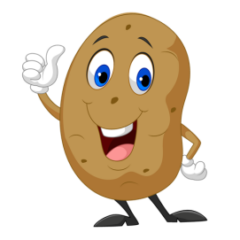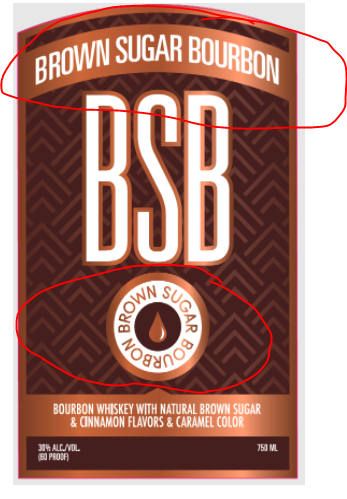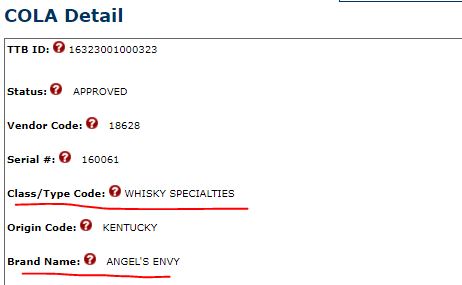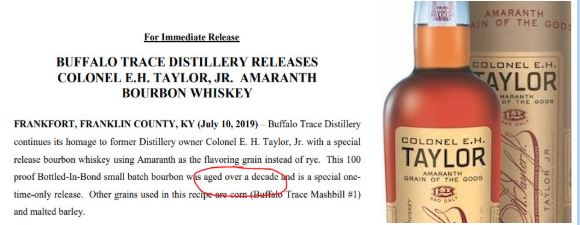I recently uncovered a “transparency” page on Uncle Nearest’s website, but what I found only deepened my suspicions about their marketing practices. For a brand that touts honesty, their actions seem to tell a different story.
I have long felt Uncle Nearest has been deliberately vague about their product’s true nature. They oscillate between labeling themselves as “bourbon” or “Tennessee whiskey” for awards, yet their bottles consistently bear the generic “whiskey” designation (Class Type 140) – a catch-all for spirits that don’t fit established categories.
I toured their “distillery” last year further fueled my skepticism. While acknowledging the powerful historical narrative of Uncle Nearest, I found the operational aspects of the tour to be a facade. A pointed-out still was non-functional, and the barrel storage facility was largely populated by empty props. This suggests a deliberate effort to create an illusion of a fully operational, independent distillery.
The “transparency” page attempts to explain away the lack of a “Tennessee whiskey” label, offering a carefully constructed narrative that, upon closer inspection, appears to be a half-truth. I suspect the real reason lies in the restrictions imposed by their initial whiskey suppliers, a crucial detail seemingly omitted from their “transparent” explanation.
Uncle Nearest claims to have transitioned to distilling their own whiskey at DSP-TN-21144 in Columbia, TN, starting in 2021. However, looking into that DSP number reveals it shares an address with Tennessee Distilling Ltd. – a company whose primary business model is supplying bulk whiskey to other brands. While Uncle Nearest can technically claim to have their own DSP number, sharing an address with a known bulk supplier on a page dedicated to “transparency” strikes me as deliberately misleading. This isn’t transparency.
TRANSPARENCY – Uncle Nearest Premium Whiskey – 100 Proof from Tennessee Uncle Nearest Premium Whiskey – 100 Proof from Tennessee
Category: Label Issues
posts about labeling issues
Fanciful Name Fallacy
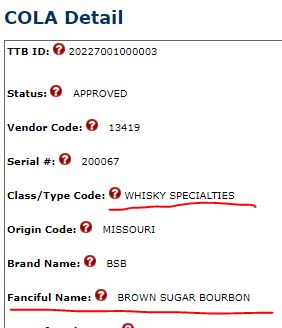
Brown Sugar Bourbon? We all know that Bourbon by code can’t have any coloring or flavorings, so how does this grotesque whiskey exist? The answer is ‘Brown Sugar Bourbon’ is not Bourbon but a Whiskey Specialty; it’s listed in this product’s COLA application as a fanciful name.
When a spirit type does not fall under any one clear class/type designation, the TTB encourages the producer to use a fanciful name to describe it. Most products marketed as ‘Moonshine’ use that word on their label as a fanciful name; it does not exist anywhere in federal code as a class/type. It’s all marketing trend words.
‘American Single Malt’ does not exist as a class type yet plenty of producers have this listed on their label. If you check the COLA label on these, you will see they are using this as a fanciful name. The brand name is Westland and the class/type is the general category of Whiskey. This is simply Westland Whiskey with American Single Malt squeezed in between.
The TTB describes a fanciful name as “a term used in addition to the brand name for the purposes of further identifying a product”. The TTB also states that product labels should not be misleading. In the case of American Single Malt, I think it’s fair to say it correctly identifies the whiskey and provides a consumer with a better understanding of the product in the bottle, which is a whiskey derived from malted barley produced at a single distillery in the USA.
But what about Brown Sugar Bourbon? First they are using an actual class/type whiskey, Bourbon, in their fanciful name. That does not help a consumer further identify the product, it does the opposite and creates consumer confusion – is this a Bourbon distilled from brown sugar?
They use the term not once but twice and in a much larger font than the actual statement of composition which is ‘Bourbon whiskey with natural brown sugar & cinnamon flavors & caramel color’. I asked the TTB about this and their response was “they look at labels in their entirety when determining whether a label is compliant (including whether it may be misleading to the consumer).” This is also bottled at 60 proof. Bourbon by code has to be bottled at 80 proof. So the statement of composition should also include diluted with water. How far can a spirit go away from being Bourbon and the TTB allow a statement of composition to cover all? My fanciful name in large type will be Marzipan Bourbon. In the small print statement of composition it will be listed as Bourbon with 60% GNS added with coconut nibs, marzipan and caramel coloring diluted with water to 40 proof. We will see if Fred Minnick will include this in one of his tastings.
Label artwork courtesy of Todd Grube.
The Scotch Whiskey Association would never allow whiskey with these types of flavors added to be marketed as Scotch. In the USA we have the TTB that enforces what defines Bourbon. By allowing products like this into the market they are lowering the bar for what consumers think of bourbon and long term my opinion is that will have detrimental effects.
Label says Bourbon but it’s not?
One of the things that make Bourbon unique is that nothing can be added post distillation other than water. This is true regardless if it’s labeled Bourbon or Straight Bourbon. Other American whiskey types such as Rye, if it’s not labeled Straight, can have up to 2.5% HCFBM, which stands for Harmless Coloring Flavoring Blending Materials. This could include caramel coloring or lab created flavoring. Which is why I often comment with the phrase ‘If it’s not Straight, you must abate’.
I was asked today about a product that said, ‘Straight Bourbon with Dark Cherry and Bourbon Vanilla Beans’. They wondered since Bourbon can have nothing added but water, how this product could be labeled Bourbon? The same question is often posed to me about Bourbons that are finished in a secondary barrel such as port. Obviously, a port barrel will add both coloring & flavoring. Also, Bourbon is only allowed to be aged in new charred oak containers, in which a used port barrel clearly does not meet this qualification.The answer is found in Ch. 7 of the TTB BAM.
The TTB allows a producer to state Bourbon, or Straight Bourbon, on the label of these products as long as it is followed with the statement of what was done to it that made it no longer Bourbon. This is required to be on the front label. The example given by the TTB is the addition of Yellow #5, but this same concept applies to the example above of added cherries and vanilla as well as for whiskies finished in secondary barrels.
The TTB makes it very clear that these additions change the class type if the original class type prohibited any additives. These whiskies become class type 641 – Whiskey Specialties. Bourbon is class type 141 and Straight Bourbon is class type 101. You can look up the COLA label approval for these products and see that they are class type 641. Example:
The label on this product says Angel’s Envy Kentucky Straight Bourbon Whiskey Finished in Port Wine Barrels. Is it Bourbon? No, it’s a Whiskey Specialties.
I’m also frequently asked about whiskies that have some type of staves or spires added to them, such as Maker’s Mark 46. These additional staves fall under added HCFBM. They are specifically addressed by CFR 27 5.39 (c) which states “Treatment with wood. The words “colored and flavored with wood ___ (insert chips, slabs, etc., as appropriate)” shall be stated as a part of the class and type designation for whisky, in whole or in part, with wood through percolation, or otherwise, during distillation or storage, other than through contact with the oak container.” So are these bourbon? No, they are Whiskey Specialities.
Many consumers do like these products and this post is not a commentary on the quality of any of these whiskies. It’s an explanation of why these products are class type whiskey specialties. Bourbon does have special protection in the USA. The well documented history of whiskey in America shows that rectifiers cut and added all sorts of materials to stretch whiskey or try to make inexpensive whiskey taste better with short cuts. In some ways I see these class type 641 whiskies as going against the hard fought battle that earned Bourbon it’s place and protection in the USA and around the world. By having the words Bourbon followed by an explanation on the bottle causes consumer confusion. The 641 class type is a catch all for whiskies that don’t fit neatly into any other type. My hope is that the TTB at some point defines some improved class types for these whiskies. I would also like to see age statements allowed. I would suggest calling these products Finished Whiskey on the front label & allowing the producer to then state the type of whiskey used along with whatever process on the back label.
Advertised age statements – Does the collar match the cuffs?
When is an age statement not an age statement? In my previous blog post, https://tater-talk.com/2019/07/23/rums-misleading-age-statements-and-other-lies/, on misleading age statements in rum I listed 3 ways producers mislead consumers. Today I’ll look at another common way spirit producers abuse age statement requirements. I’ve seen this method used by all types of spirits.
The TTB regulates alcohol beverage advertising. Obviously, this includes rules on what can and can’t be stated on the product’s label. This also extends to ads in newspapers, magazines, TV or radio broadcasts, internet based social media, as well as websites.
I’ve talked before about how some whiskey blog posts basically repack a brands PR on a new product as their new blog post. Often these include an age reference, but the actual bottle is NAS – No age statement. I’ve always found this to be disingenuous; if the whiskey is “X” years old, then state it on the bottle. This violates TTB code:
CFR 27 5.65 (b) (2) (c) Statement of age. The advertisement shall not contain any statement, design, or device directly or by implication concerning age or maturity of any brand or lot of distilled spirits unless a statement of age appears on the label of the advertised product.
Unless the bottle carries an appropriate statement of age, the producer can make no claims of age in the advertising.
Let’s look at some blatant examples of producers violating this.
The new Buffalo Trace grain of the tater bottling, oops I mean the new Buffalo Trace E.H. Taylor, Jr. Amaranth Straight Bourbon whiskey in their PR states it is aged ‘over a decade’. Yet the actual product released is NAS.

Flor de Cana states on their website their rum is 18 years old. The actual bottle has just a number which is not an age statement.

Here is Michter’s website saying this whiskey is a blend of 10 to over 30 year old whiskeys. The actual bottle has no age statement.
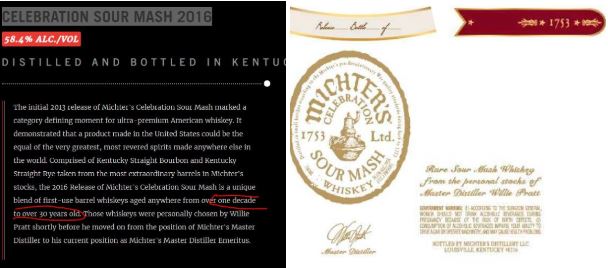
This is from the website for Straight Edge. This is a bourbon finished in XYZ cask, which makes it a class type 641 Distilled Spirits Specialty and by code not allowed to state an age statement.

Are these producers not aware of the US federal code? Are they misleading consumers on purpose? Perhaps the first release is the PR advertised age statement, but future releases will be much younger? I know I will trust for fact what is actually on the bottle and discount anything in advertising.
Rum’s misleading age statements and other lies
There are many brands of rums who IMHO are guilty of misleading consumers about the ages of their rums. This is done in 3 ways:
1. Stating a number on the label without actually calling it an age statement.
2. Using a solera system where only a small fraction of the rum matches the age statement.
3. Complete fabrication.
UPDATE June 2022. Flor de Caña has updated their labeling and now their rums carry actual age statements. They have been removed from my brands not to purchase list.
An example of #1 is Flor de Caña. They sell a range of aged rums which carry a number 7, 12, 18, or 25 on the label. Next to that, instead of saying years old, they state ‘slow aged’, which means nothing as it has no legal definition so it is just a marketing gimmick. They depend on retailers who will happily tell consumers in their advertisements and shelf tags that these products are actually ‘X’ years old. They even advertise that they are ‘Fair Trade Certified’.

Before I address #2, let’s look at the TTB rules on age statements for spirits. From the TTB BAM Ch. 8 we find: “Age is the period during which, after distillation and before bottling, distilled spirits have been stored in oak containers”, “Age may be understated but may not be overstated”. There are no exceptions for rum or for solera processes, which I’m convinced in Spanish means bullshit age statement. So unless every single drop of a rum in the bottle has been aged in oak containers for at least 23 years, then that producer can’t label their product with a 23 year age statement. Zacapa 23 is not a 23 year old rum which consumers often mistake it as.
That brings this to example #3. Without doing a compliance check by visiting each distillery it’s not possible for me to name brands. I can do the math though. Rums aged in the tropics lose an incredible amount to angels share each year, from 7 to 12% a year. Producers do consolidate barrels as they age which helps, but does not stop this process. Losing 10% the first year and 7% each year after, which is the low end, the angel’s share is 60% after year 12. It’s an 82% loss by year 23. Start factoring in the time and expense of holding inventory for 23 years, the cost of exporting to the US, federal taxes, importation cost, the wholesaler’s and the retailer’s cut, it’s easy to see that when you see rums for sale for under $50 that boast age statements of over 20 years, alarm bells should be ringing.
The rum brands on my naughty list I will not buy include:
Antigua Porteno
Botran
Canasteros
Centenario
Dictador
Dos Ron
Kirk and Sweeny
Matusalem
Opthimus
Papa’s Pilar
Villa Rica
Vizcaya
Zacapa
Zafra
Now getting into the brands that add sugar or other sweeteners post distillation without disclosing such is a whole other issue for a future blog post.
Saint Cloud Bourbon – hop off the hype train
2019 bourbon drinkers, or least the type that likes to read whiskey blogs, seem to always be searching for the next big thing. This is especially true if it is new and they can ‘get in on the ground floor’. Whiskey bloggers are more than happy to get the page clicks or podcast/YouTube views, so they promptly gush all over the new guy in the market. Being first to get a review out from a free brand provided sample bottle is important work for these types. Most of these blog posts are the PR points of the brand regurgitated into an article along with some tasting notes. But since you are reading my blog you know my angle will be different and I will dig a little deeper.
Today’s new flavor of the month bourbon is St. Cloud. Sites like The Whiskey Wash and Breaking Bourbon have quickly done their thing with little to no due diligence performed. Ray Walker is the person behind this new brand of bourbon. Ray fancies himself as a successful entrepreneur. He started a French wine company, Maison Ilan, and claims he was the first American to make Grand Cru Burgundy wine. In 2011 he was featured in a New York Times piece. He wrote a book, The Road to Burgundy, that reached 15th on the Los Angeles Times bestseller list in August 2013. His wines at this point were in massive demand with futures sold only to the lucky buyers who had ‘got in on the ground floor’. Two years later the bottom fell out and buyers did not receive their wine, which was paid for upfront. The winery was bankrupt and shut down. Just as there are bourbon forums, there are wine forums where many of these buyers have vented their concerns and consider Ray a huckster. Ray himself admits orders have not been fulfilled and has promised to make these buyers whole, but to date for some this has been nothing but an empty promise. This is not the first time Ray has made serious business mistakes that cost others money. When he was in his twenties he dealt in BMW parts where he also left buyers with unfulfilled orders. Ray explained this away as being young and irresponsible. If you wish to read more about the fall of Maison Ilan, please see this article – https://www.burgundy-report.com/burgundy-report-extra/09-2016/the-spectacular-rise-fall-of-maison-ilan/
Ray Walker is now trying to shed his past reputation and rebuild his brand with a sourced bourbon. The Saint Cloud website mentions it’s made using a “perspective that comes only from making Grand Cru in one of the world’s top wine regions”. For me this just screams marketing spin as Bourbon is uniquely American and has very little to do with wine making. The website says the bourbon is unique and refined being “produced in a traditional manner using a hybrid pot-column still without the use of many other modern aides and equipment”. There’s nothing unique about pot-column hybrid stills as those are the most common used stills by craft distillers across the US. I am curious what modern aids and equipment are forgone.
This product at one point was pitched as L’Americaine Kentucky Bourbon. Perhaps this was a little too French as it was launched as Saint Cloud Kentucky Bourbon. Batch one is apparently from 12 barrels and yielded 3000 bottles. The website says it was distilled in 2016 and bottled in March 2019. This could be a 2 year or possibly a 3 year old bourbon. We know that federal code requires all American whiskies under 4 years to have an age statement. Here is their required age statement:
It states under 4 years. This is not a TTB compliant age statement. The TTB even has an online FAQ that covers age statements that specifically list this as not acceptable. See S11 here – https://www.ttb.gov/spirits/faq.shtml
Is this product Bourbon or Straight Bourbon? The above label which is placed on the side of the label says Bourbon in one spot and Straight Bourbon in another. The class type is required by code to be on the front of label; the front of neck label on the bottle states Bourbon. Their website mentions that it is Straight Bourbon. Perhaps it’s a case of someone with a wine background who does not know the difference?
Also, this is Bourbon. Redesigned. Jim Beam just ‘redefined’ Bourbon last month with their Legent whiskey. Who will ‘reconceive’ bourbon next month?
The website has some lovely videos that spends more time showing the bottle being produced than the bourbon. I’ll grant the packaging is very nice and my estimate accounts at the retail level for about a third of the price. Speaking of price, we have another young bourbon that is over the $100 price point; this is listed on their website with a purchase price of $114.99 per bottle. The chairman of Diageo Javier Ferran once said “A key driver of perception of quality is price”. Looks like they are taking a page out of the Diageo playbook.
Why are the blog sites hyping up such a limited release from a new company run by a person with a questionable business background? My answer is they cater to taters who only care about owning, likely to later flip, a bottle that is a limited release, be it any limited release, as long as the hype can drive up the secondary market.
The Whiskey Wash ignored my request for a comment. https://thewhiskeywash.com/whiskey-styles/bourbon/new-saint-cloud-kentucky-bourbon-crafted-by-former-winemaker/
Breaking Bourbon responded with “His prior business failure and sorting through that mess, however, was not the focus of the tasting notes for the bourbon.” https://www.breakingbourbon.com/tnt/saint-cloud-kentucky-bourbon-2016-batch-1
Next level label deception – Old Fourth Distillery
A friend recently asked if I knew anything about Old Fourth Distillery out of Atlanta, specifically about a Bottled in Bond straight bourbon they had recently released. I did not, so I googled their website and did a little reading. I also looked up their COLA label approval. The Bottled in Bond Act has some very specific requirements about labeling. At first glance from what I read I thought surely they had distilled this bourbon, they fooled me. Their website proudly proclaims, “Atlanta’s Own Straight Bourbon Whiskey Aged 4 Years”. The website says they knew they wanted to make whiskey when they opened in 2012, they barreled this bourbon in Jan. 2015, and it’s taken 4 years for the initial release. It’s very careful wording without ever saying distilled. The friend then sent me a blown-up picture of their label zooming in on some print hidden in some artwork that showed DSP-IN-15023. Can you spot this in the picture below?

The “IN” portion indicated this bourbon was distilled in Indiana. One would then assume the likely source would be MGPi, but their DSP is IN-15016. Despite the dubious DSP number, I have confirmed this was distilled by MGPi.
I emailed one of their owners to express my concerns about the deceptive website information as well as to bring to their attention some specific sections in the TTB code they are violating. It’s been a week with no response, so the blog is going up without comment from them.
They are in violation of 27 CFR 5.36 (d), which I have blogged or posted about many times. If certain types of whiskies are distilled in 1 state but bottled in another, then the label must have a ‘Distilled in XYZ state’ statement. In this case, they must say Distilled in IN on the label.
For Bottled in Bond spirits, the code says “27 CFR 5.42 (b) (3) – the label shall bear the real name of the distillery or the trade name under which the distillery produced and warehoused the spirits, and the plant (or registered distillery) number in which produced; and the plant number in which bottled. The label may also bear the name or trade name of the bottler.” While they list an IN DSP number cleverly buried in the artwork, they don’t list MGPi by name nor do they list their DSP number on the label as required by this code.
It must take a lot of work to be this deceptive. It would be so much easier to be upfront with customers about your process and sourcing. Plenty of companies such as Smooth Ambler, High West, and others have found much success with the upfront disclosure business models. In 2019, I’m surprised we still find those that like to engage in such deception. Shame, Shame, Shame.
Update – I emailed a preview of the above blog post and did receive a response from one of the owners. He said “We are very sorry that you feel deceived by our product. We openly tell our customers that we sourced the white whiskey from mgp and aged it 4 years in Georgia.”
Here is link to their website page on this bourbon; you can decide for yourself if they are being open that it is sourced whiskey. https://o4d.com/bottled-in-bond/
Maker’s Mark answers label question
On the label of Maker’s Mark bourbon you will find “Maker’s Mark is America’s only handmade bourbon whisky – never mass produced”. Looking through the COLA database, this statement goes back for at least 14 years. I visited my local store and it was on every bottle I saw in both 750ml and 1.75liter.
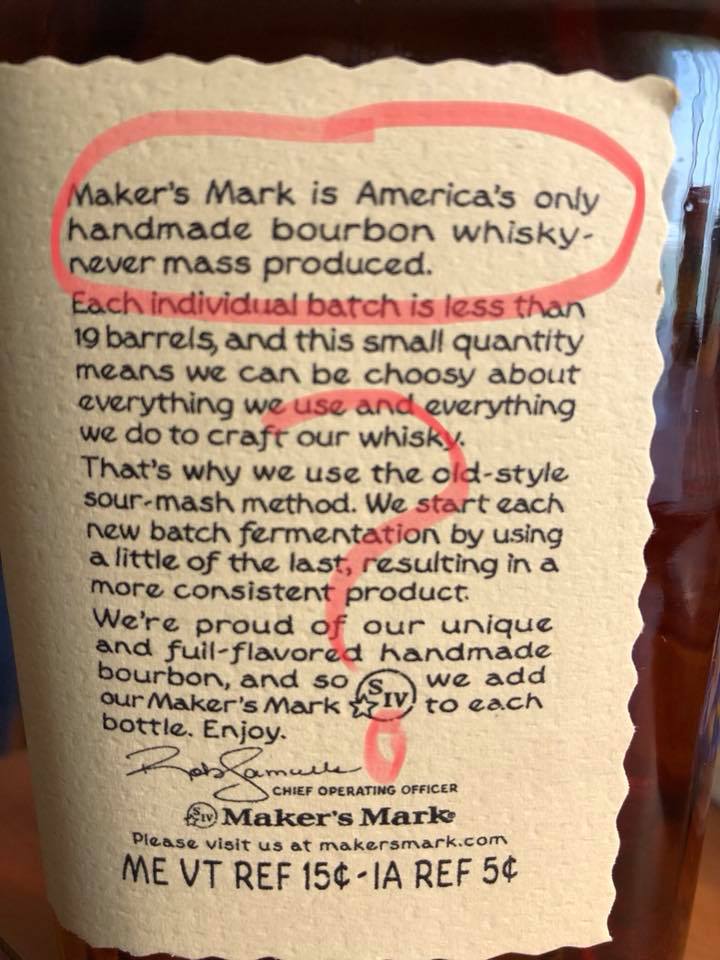
I have visited close to 100 distilleries located all over the world. Some have been very technologically advanced with computer screens and automation performing some of the work while others have been at the opposite end with every valve hand turned by a person. I would say every distillery I have visited could make a valid claim of being handmade. At some point in the process hands are involved. For instance barrels are all rolled by hand. You will not find any definition of handmade in the TTB’s CFRs. Maker’s Mark hand dips all of their bottles. So, I have no issue with Maker’s use of handmade on the label. They also claim never mass produced. Again, there is no legal definition for mass produced in the CFRs, so it is just a marketing statement.
What I found perplexing was their use of the word ‘only’. With the boom of new craft distilleries in the US in the last 10 years certainly there are plenty of whisky distilleries operating on a smaller scale than Maker’s Mark with more hands-on involvement. Frankly I was flabbergasted they would dare to make this statement.
When I started writing this blog post, the first thing I did was reach out Maker’s Mark to see if they would like to comment on this. I received a response back the very next day. Here is the message:
“As the category has evolved, we have made updates to the label, including removing the word ‘only.’ Sometimes inventory takes a while to clear off the shelves, so it’s entirely possible that you’ve seen or even purchased bottles recently that still have this language (as noted in your picture). However, new bottles coming out of the Maker’s Mark Distillery today no longer include the word ‘only’.”
I was expecting to post a hard take on this issue and see if it would convince them to change. Looks like they outdid me; good for them for making this change. At least Bourbon geeks in the future will be able to quickly glance at a Maker’s Mark bottle and proclaim that’s a pre or post 2018 label change bottle.
Let me know in comments if you see a bottle with a label that reflects this new change. Update – Confirmed sighting of new label as of November 2018.
